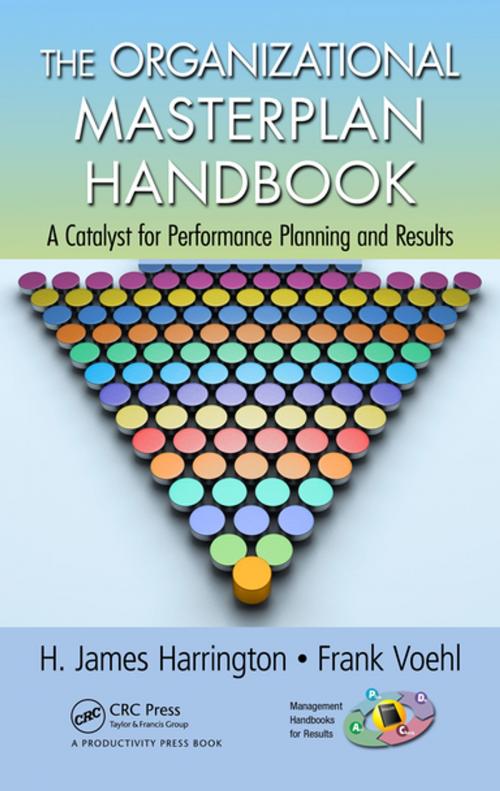The Organizational Master Plan Handbook
A Catalyst for Performance Planning and Results
Business & Finance, Industries & Professions, Quality Control, Management & Leadership, Management Science, Nonfiction, Science & Nature, Technology| Author: | Frank Voehl, H. James Harrington | ISBN: | 9781466558885 |
| Publisher: | CRC Press | Publication: | April 5, 2012 |
| Imprint: | Productivity Press | Language: | English |
| Author: | Frank Voehl, H. James Harrington |
| ISBN: | 9781466558885 |
| Publisher: | CRC Press |
| Publication: | April 5, 2012 |
| Imprint: | Productivity Press |
| Language: | English |
For visionary leaders, an Organizational Master Plan and associated technologies have become essential components of strategic decision making. Written for leaders, planners, consultants, and change agents, The Organizational Master Plan Handbook: A Catalyst for Performance Planning and Results explains how to merge the four planning activities that compose the Organizational Master Plan to manage, improve, and maximize organizational efficiency and effectiveness.
Written by recognized leaders in applying Performance Improvement methodologies to business processes and entire organizations, this book defines the makeup and highlights the differences in the operating plan, strategic business plan, strategic improvement plan, and the organization’s business plan. It defines each and explains how to link them to reduce costs and cycle times. Describing how to use controllable factors as the foundation for constructing your Organizational Master Plan, it demonstrates how the plan fits into organizational alignment activities.
- Examines all the plans that should go on within an organization and details the purpose of each
- Unveils a novel approach for preparing a Strategic Improvement Plan
- Lays out a well-defined roadmap of the Organizational Master Plan process
Explaining how to make the strategic planning process a part of performance plans for individuals within your organization, the text incorporates sufficient flexibility so you can adapt and revise the plans discussed according to changing business needs and marketplace opportunities. It explains how to develop a set of vision statements to define how your organization will function five years in the future as well as how to develop the strategies needed to make the required transformation a success.
Praise for the Book:
Harrington and Voehl present the most comprehensive and effective approach to optimizing an organization’s performance developed to date.
—Tang Xiaofen, President of the Shanghai Association for Quality & President of the Shanghai Academy of Quality Management
Compulsory reading for all leaders to maximize efficiency and effectiveness while navigating business in this risky global economy.
—Acn. Shan Ruprai President APQO, National Chairman Australian Organisation for Quality, and Chairman AIBI Australia
A Note from the Authors:
Organizational Master Plans are tangible and often visible statements of where the organization is now, what it should be in the future and what is required to get there. While processes for developing them vary, master plans are most successful when they represent a vision that brings together the concerns of different interest groups, and their recommendations create a ground swell of business community and political support. Good Organizational Master Plans are flexible, and have involved the business leaders and other stakeholders from the outset, giving the plan a legitimate base, and a better chance to come to fruition. While circumstances vary from place to place, the decision to develop a master plan is often determined by the need to understand the current conditions of the marketplace, to generate and build stakeholder interest and participation, to create a new and common vision for the future, and/or to develop a clear and solid set of recommendations and implementation strategy.
Susan Rademacher, executive director of the Louisville Olmsted Parks Conservancy, had this to say about the process of developing Louisville’s Organizational Master Plan:
. . .When we got started with our master plan, there were a few important things that we focused on. One was that we started with a belief in the native intelligence of this community, from 1888 forward. And we invited the public to really dream about what these parks could be, what they remembered the parks as, and we tried to change expectations in that way. Typically in the past, …the little changes that come about in parks are politically motivated to get a big bang in the short term for the next election. And … our parks were suffering from that. So when we invited the community to dream large, we changed the expectations and also changed the expectations of what the public sector was looking to do.
For visionary leaders, an Organizational Master Plan and associated technologies have become essential components of strategic decision making. Written for leaders, planners, consultants, and change agents, The Organizational Master Plan Handbook: A Catalyst for Performance Planning and Results explains how to merge the four planning activities that compose the Organizational Master Plan to manage, improve, and maximize organizational efficiency and effectiveness.
Written by recognized leaders in applying Performance Improvement methodologies to business processes and entire organizations, this book defines the makeup and highlights the differences in the operating plan, strategic business plan, strategic improvement plan, and the organization’s business plan. It defines each and explains how to link them to reduce costs and cycle times. Describing how to use controllable factors as the foundation for constructing your Organizational Master Plan, it demonstrates how the plan fits into organizational alignment activities.
- Examines all the plans that should go on within an organization and details the purpose of each
- Unveils a novel approach for preparing a Strategic Improvement Plan
- Lays out a well-defined roadmap of the Organizational Master Plan process
Explaining how to make the strategic planning process a part of performance plans for individuals within your organization, the text incorporates sufficient flexibility so you can adapt and revise the plans discussed according to changing business needs and marketplace opportunities. It explains how to develop a set of vision statements to define how your organization will function five years in the future as well as how to develop the strategies needed to make the required transformation a success.
Praise for the Book:
Harrington and Voehl present the most comprehensive and effective approach to optimizing an organization’s performance developed to date.
—Tang Xiaofen, President of the Shanghai Association for Quality & President of the Shanghai Academy of Quality Management
Compulsory reading for all leaders to maximize efficiency and effectiveness while navigating business in this risky global economy.
—Acn. Shan Ruprai President APQO, National Chairman Australian Organisation for Quality, and Chairman AIBI Australia
A Note from the Authors:
Organizational Master Plans are tangible and often visible statements of where the organization is now, what it should be in the future and what is required to get there. While processes for developing them vary, master plans are most successful when they represent a vision that brings together the concerns of different interest groups, and their recommendations create a ground swell of business community and political support. Good Organizational Master Plans are flexible, and have involved the business leaders and other stakeholders from the outset, giving the plan a legitimate base, and a better chance to come to fruition. While circumstances vary from place to place, the decision to develop a master plan is often determined by the need to understand the current conditions of the marketplace, to generate and build stakeholder interest and participation, to create a new and common vision for the future, and/or to develop a clear and solid set of recommendations and implementation strategy.
Susan Rademacher, executive director of the Louisville Olmsted Parks Conservancy, had this to say about the process of developing Louisville’s Organizational Master Plan:
. . .When we got started with our master plan, there were a few important things that we focused on. One was that we started with a belief in the native intelligence of this community, from 1888 forward. And we invited the public to really dream about what these parks could be, what they remembered the parks as, and we tried to change expectations in that way. Typically in the past, …the little changes that come about in parks are politically motivated to get a big bang in the short term for the next election. And … our parks were suffering from that. So when we invited the community to dream large, we changed the expectations and also changed the expectations of what the public sector was looking to do.















